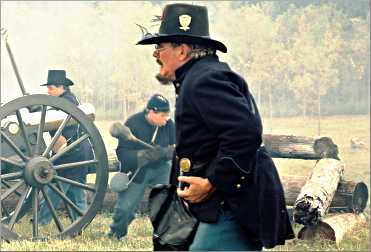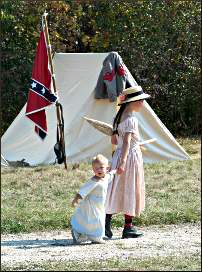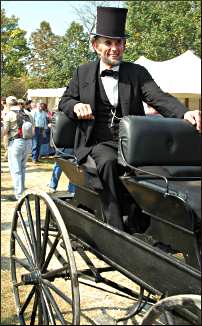Blasts from the past
Every September, the Civil War comes to an old stagecoach inn in Wisconsin.

© Beth Gauper
The forest was quiet and the afternoon still. Unnaturally still.
Fifteen Union Army infantry units were camped around wagons in a meadow, near artillery and cavalry. Along a split-rail fence, a drum-and-fife corps pounded drums and blew trumpets.
Gunners began to load their muskets. The cavalry got on pawing horses. Then a Union skirmish line marched down the meadow, followed by a tight column of infantrymen.
On the other side of the meadow, a Confederate skirmish line exchanged musket fire with the federals. Suddenly, more gray-uniformed soldiers burst from the woods and attacked the heart of the Union column. The thunder of cannons filled the air. The blue uniforms fell back.
Then the second-guessing began.
"Could have won in the first 10 minutes if they'd got those first 12 men," grumbled a man on the sidelines. "So much for a counter attack," groused another.
What year is this, anyway?
It's the 21st century at the Wade House in Greenbush, Wis., but 1864 to the 1,200 Civil War hobbyists who have gathered to re-enact the attack on Tupelo, an important rail junction in northern Mississippi.
The initial federal setback was temporary; the battle turned into a stinging defeat for the Confederates, who lost 1,326 men to the Union's 674.
When it ended, the rebels had been kept from the federal supply lines, and Gen. William T. Sherman was at the door to Atlanta.
Greenbush is no Tupelo. For the thousands of spectators gathered near this east-central Wisconsin town to witness a part of the bloodiest war in history, there is no blood. There is no death. There is not as much noise as there would have been in 1864, because the muskets are firing blanks.
But boy, is there atmosphere. Plenty of atmosphere.

© Beth Gauper
A few yards from the crowd, an artillery unit is urgently loading, ramming, priming, and firing their lethal-looking cannon. There's a flash, a billow of acrid white smoke and a raw boom that reverberates to the pit of the stomach.
Boom! Boom! It's only aluminum foil they're stuffing down the barrel, but the gunpowder is real, and it delivers a charge of 18,000 pounds per square inch, enough to blow the arm off a careless loader.
Suddenly the Union gunners retreat, and a scruffy band of rebels takes over the cannon. Stocky figures in blue and gray lie amid the grass. A Civil War-era nun hovers nearby, fingering a rosary.
Now a column of blue uniforms emerges from the smoky fray, and the rebel gunners retreat. A Confederate captain on a dashing black horse, carrying a white streamer on a saber, rides to meet a Union officer; they call a brief truce to pick up the dead and wounded.
Then, the fighting continues. On the far side of the valley, a federal cavalry unit with revolvers is rushing a Confederate unit that has sabers drawn.
It's all terribly confusing, just as Civil War battles were to those who fought in them. Here, as in the real Battle of Tupelo, Confederate effectiveness was weakened by brigades who launched uncoordinated assaults.
After the battle and military review, the soldiers retire to the vast tent city at the bottom of the hill. The living history has just begun. Beef stew and pippin pies are for sale, along with Dr. McGillicuddy's cherry-bark spring beer.
An amputation is scheduled in the medical tent, and a blacksmith is cranking the bellows at the Bighorn Forge. A row of sutlers sell everything a gentleman or lady needs: carpetbags, Confederate currency, whalebone hoops for the ladies.
It's expensive to be a re-enactor. A period musket with bayonet can cost $1,000; an authentically reproduced uniform with hat, boots, canteen, haversack and other accouterments can cost another $1,000.

© Beth Gauper
The cost of a woman's outfit also can add up, if it's complete with hoop, petticoats, brooch, braiding, gloves, cape, snood and plumed hat.
Outside the white canvas tents, Kevin Griffin of Galena, Ill., is cleaning his rifle; he plays Thaddeus Sweeney, a fictional private in the 10th Tennessee Volunteers.
"No matter what they say, this is guys playing with guns and girls playing dress-up," he says roguishly. Griffin's particular interest — the Civil War, he says, is "a bottomless pit of things of interest" — is the 11 Irish regiments in the rebel army.
"Until the Civil War, the term Fighting Irish was an ethnic slur," he says. "They were known as good fighters; otherwise, you couldn't trust them."
In a sutler's tent, Bruce Barraclough of Milwaukee is looking at re-enactors journals and newsletters. He's a Confederate, too, an artillery commander with Miller's Battery.
He likes guns and atmosphere, and rates the Greenbush grounds highly for their sprawling woods and isolation from modern intrusions.
"That gives you the ability to get lost in the era, to get your adrenaline pumping," he says. "It was rather intense out there today."
So intense, says a Union major, that too many men fell down on the job by not falling enough. Maj. Jack Grothe of St. Louis, Mo., is doing what a staff officer does best: upbraiding his men.
"Nobody wants to be the first one out of the box, to fall over and miss the whole thing," said Grothe, a longtime re-enactor. "When we do it for Hollywood, the cannon goes off and 10 men go down. It looks a lot better."
Women too, had many roles in the Civil War; they were nurses, spies — and widows.

© Torsten Muller
Walking along a gravel path, Laurie Becker of Sussex, Wis., looks as if she has stepped from the pages of Civil War Lady magazine; she's decked out in a burgundy print dress with velvet cape and hat with teal and burgundy feathers.
Becker plays her own great-grandmother, Catherine Elizabeth Fitzgerald of Manitowoc, whose husband was killed at Fredericksburg, Va.
"There are all these family stories, and I just share those," she said. "I found out about it through diaries and letters. It's amazing how much there is out there if you dig."
The best re-enactors come to the best events. The Greenbush battle re-enactment and encampment, begun in 1991, quickly garnered great word-of-mouth, and each year it grew bigger until it was discontinued in 2023.
The Wade House, an 1850s stagecoach inn that was the halfway point on the oak-plank road between Sheboygan and Fond du Lac, is one of the smaller sites operated by the Wisconsin Historical Society.
But it is blessed with 280 acres of woods and fields, along with rock-walled sunken roads that, says director Jeff Schultz, were built by Yankee pioneers and "looked like something out of Gettysburg or Fredericksburg."
No Civil War battles were fought in Wisconsin. But many soldiers from Wisconsin fought, and the Wade House once was a recruiting station; its proprietor, Sylvanus Wade, was an avid patriot.

© Torsten Muller
Many of the re-enactors wore the square hats that identified them as members of three Wisconsin regiments, who, with an Indiana unit, became known as "The Iron Brigade," or, to the rebels, "the terrible Black Hats."
Participating in these events, says Laurie Becker, gives her a chance to "shut out the world for a weekend."
The re-enactors are the key to a good event, said Schultz. For as they observe the routines of life during the Civil War, everyone else gets to observe them.
"For the public, it's a sideways glance at history," Schultz said. "You can smell the bacon, and see who's cooking it. It transports you back; you feel like a time traveler."
Trip Tips: Civil War Weekend at the Wade House
Getting there: Greenbush is an hour north of Milwaukee.
Civil War Weekend at the Wade House in Greenbush, Wis. It's been discontinued.
For other Civil War battle reenactments in the Upper Midwest, see Still fighting the Civil War.